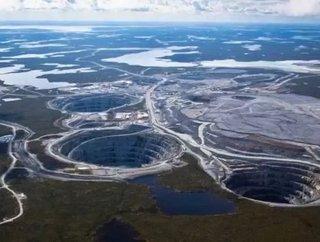Dominion Diamond Corp: Inside the Ekati Diamond Mine

The Ekati Diamond Mine in Canada is the country’s first surface and underground mine. Ekati, a Tlicko word for ‘fat lake,’ began production in October 1998 after over a decade of exploration and development work. It’s located in the Lac de Gras region of the Northwest Territories, and is renowned for its premium gem-quality diamonds.
Dominion Diamond Corp, a Canadian diamond mining company formerly known as Harry Winston Diamond Corporation, acquired the mine in April 2013. It reached an agreement with BHP Billiton in November of 2012 to purchase all of BHP Billiton’s assets, which included controlling interest in Ekati.
Their 80 percent ownership in the mine was $553 million. The other 20 percent of the mine is held by Charles E. Fipke and Stewart Blusson, with 10 percent each. Dominion holds 80 percent of the Core Zone – the current operations and other permitted kimberlite pipes – and 58.8 percent of the Buffer Zone – which consists of the developmental and exploration potential of the region.
Ekati produces around 3 percent of the world’s current rough diamond production by weight; it produces 5 percent by value. Although it’s located in the Canadian sub-arctic – where cold winter conditions are a reality for a majority of the year – mining activities are conducted year-round.
Production was originally focused on six open pits, and current mining is conducted at Panda, Koala, Fox, Beartooth, Pigeon, Sable and Misery orebodies. Major production comes from ore sourced from the Fox open pit, which contains lower-grade but high-carat valued ore. This is supplemented by ore from the Koala and Koala North kimerlite pipes.
As mentioned previously, kimerlite pipes are the main deposit type for the mine. Eight hundred full-time staff is employed on the site, as well as 700 contractors at any given time. An impressive 80 percent of the total production is gem quality; the largest gem mined from the site to date has be the 78-carat Ekati Spirit, which was discovered in 2010. It sold at auction in 2011.
Ekati also hit an impressive goal in 2011, producing 50 million carats over the lifetime of the mine. Although Dominion predicts carat production over the next 2 years is expected to be lower than what had been achieved – on average – over the last 5 years, it is expected to return to a higher carat production after that. The mine will be transitioning its production from the Misery and Pigeon open pits, which offer higher grade ore, but lower carat values.
The current plans for Ekati have the mine producing until 2020. However, it has been mentioned that there might be additional resources that could become profitable if diamond prices increase.






